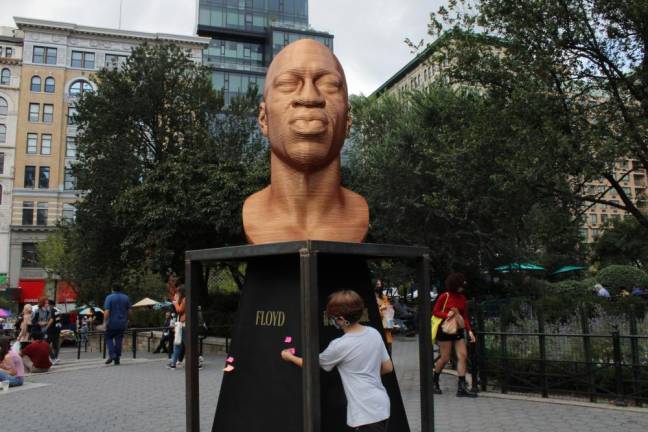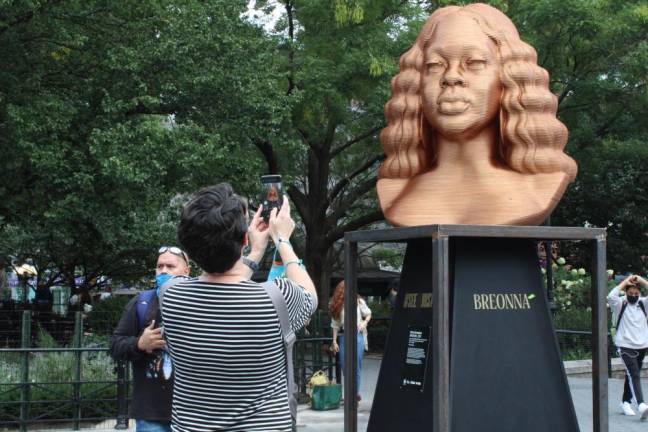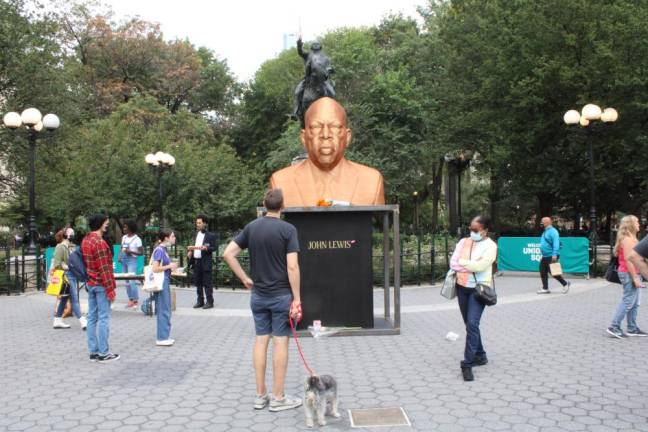The Story of the Statues in Union Square
Busts of George Floyd, John Lewis and Breonna Taylor draw attention and discussion - and an act of vandalism



On October 1, three statues were put on display on the south side of Union Square Park. The three busts featuring George Floyd, John Lewis and Breonna Taylor drew attention from passing New Yorkers and tourists alike.
“There’s been all this controversy about taking down sculptures that are not progressive, like the [Robert] E. Lee statue and everything,” says Molly Edwards, a New Yorker who stopped by to see the statues on her way to a doctor’s appointment. “I think having public art that represents the right side of history and how we want to see ourselves as society is important.”
Seventeen months after the death of George Floyd and one month after the removal of the Robert E. Lee statue in Richmond, Virginia, the United States remains embroiled in a discussion about Black lives and how art can either oppress or represent them.
The sculptures’ relatively short stay in Union Square has already been troubled. On Monday, October 4, footage was released of a man in a green jacket skateboarding past and throwing white paint on the statue of George Floyd. The other statues have remained untouched.
“Significant Moment in Time”
Shortly after the death of George Floyd, artist Chris Carnabuci, who uses stacked plates in his sculpture design and is best known for “Mariposita,” his sculpture of a woman emerging from an egg, decided to create the first sculpture in this trio. “I wanted to do something that would sort of capture this very significant moment in time,” Carnabuci says. He wasn’t concerned with creating the work for a gallery, he says. “It was more about just capturing a moment in time.”
The original work was 20 inches tall, less than a third of the size the one in Union Square. Carnabuci didn’t know what to do with his creation, so he called up his friends at Confront Art, a Manhattan-based program started last year that combines charity and art to “create this hybrid where we’re bringing really important works that have a perspective to life on a global scale,” says Confront Art Co-Founder Lindsay Eshelman.
Shortly after, Eshelman had a chance encounter with Terrence Floyd, George Floyd’s brother, and showed him the statue. She describes Floyd as being overcome with emotion and says that “he thanked us for coming to him with the project because he had seen so many artists, sell art, do t-shirts, do murals, and the family was never involved or even asked for approval.” Floyd decided to use the work in collaboration with his We Are Floyd foundation to help raise awareness about his brother’s death and police brutality.
Around the same time, Carnabuci completed a similar sculpture of Breonna Taylor, with the desire to create a third of John Lewis. He scaled up all three statues to their current size and unveiled them in Flatbush for Juneteenth. The George Floyd statue was also vandalized then.
Design Foresight
For Carnabuci, vandalism wasn’t a matter of if, but when. Though he expected something bad to happen he says, “I was actually a little surprised that it happened A) only a couple of days later and B) in broad daylight.” Eshelman described similar surprise at how quickly the vandalism occurred. “I hightailed it and over to Union Square,” says Eshelman. “I just was disheartened because I knew it’s only the George Floyd statue that continues to be targeted.” The man who did it remains unidentified.
Luckily, Carnabuci had foresight in designing his sculptures. He describes seeing the paint damage as “all too familiar” because “I’d been down that road before with the Flatbush install.” The current versions of the three busts feature a paint finish, that Carnabuci says makes it easier to clean and fix any potential damage. He says this was done mostly to “mitigate damage from water or UV light,” but protecting it from vandalism is a bonus.
Volunteers from Confront Art came in to clean up the statue. “We will persevere,” says Eshelman, who helped clean the statue. “We cleaned, we’ll clean again, and we’ll clean again.”
Carnabuci, however, is confident that another attack is unlikely. “I think that there’s more of a focus on patrolling that area,” he says. Eshelman describes seeing a familiar flag: “It was a local chapter of Black Lives Matter from the Bronx who came down and kind of started standing guard.” The volunteers, whom Carnabuci calls “the keepers,” are in Union Square every day watching the statues.
Reactions to the Statues
African Americans still face escalated rates of police brutality and bear the brunt of racism in the U.S. Noel Benett, a Black New Yorker, was happy to see representation through the statues. “As recently as the other day I went into the store over there,” he says, referencing the Burlington Coat Factory across the street. “And I’m just looking around and they accuse me of stealing. Shit like that happens all the time cause you’re Black.”
Even without the vandalism there are mixed emotions surrounding the statues. “I’m proud and at the same time I’m sad,” says Benett. “I can’t put it into words what it means to me to see something like that out there.” Other onlookers had similar reactions. Nia Waterhouse describes the statues as “a powerful way to honor their memory and their life.”
“We’re the catalyst for conversation,” says Eshelman about the art.
“I feel like they will definitely get people talking about things that need to be spoken about,” says Zhaleen Emerson, an admirer of the statues.
The statues will be in Union Square through the end of October. Right now, Eshelman and Confront Art are working on organizing a tour. She says they want to take the statues to “cities who really share similar values as New York, but also have seen similar chaos,” such as Atlanta or Chicago.
But for now, you can still go see them in Union Square Park. “I honestly think it’s a very good place for them,” says Oz Yangas, a New Yorker who came to see the statues. “This is a park that’s very well known in modern times for activism, and I think especially having these statues here will definitely inspire a lot of younger voices to probably come in and really contribute to the scene here.”